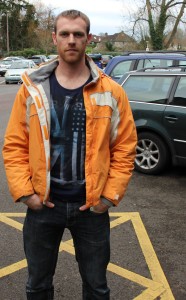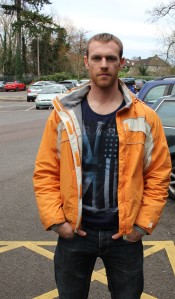1. Force perspective
Using outdoor lighting and similar framing take two portrait photos.
a) 18mm



The image is flattened with a clear background and is not especially flattering to the subject, can create ‘face bowl
1. Force perspective
Using outdoor lighting and similar framing take two portrait photos.
a) 18mm



The image is flattened with a clear background and is not especially flattering to the subject, can create ‘face bowl
Performance can be seen as part of all actions, aided by setting, defined roles, rituals, groups etc. If one is dressed in certain uniforms, say a police uniform, and in a certain situation, say a football match, one can expect a certain set of performances from the individual.
Appearance + manner = perception.
Thinking basically about young teenagers at school, they use music, sports, places etc to define who they are.
Upsetting these conventions can be very surreal – imagine a guard from Buckingham palace in full regalia going for a dip in the local swimming pool.
Performances follow a patter, part of a social agreement and convention (an expectation)
In a university learners drees a certain way and respond to their teacher, they have learning props such as pen, paper, laptop etc. The teacher may stand at the front and ask the questions or impart knowledge.
Some of these have a large variation based on nationality or cultural identity, Kate Fox’s book “Watching the English” exemplifies certain character traits on the English and how convention rules our lives. She tired social experiments such as bumping into people on purpose to view their reaction – usually an apology form the English ‘bumpee’ or extremely good avoiding actions from the Japanese. Continue reading
Alan Turing had an early prediction and idea for a modern computer “to Imitate mechanical processes” and could be proved as intelligent by applying a thought experiment to test it as a human. This would involve not being able to decipher if they were communicating with a human or a machine. This idea would involve the notion of imitating humans and that would exemplify ‘artificial life, known as the Turing test.
This term we explore the disruption of the everyday through photography. This will hinge on our ability to make an intervention and/or take a position, producing images which could take away, add in or disjoin perceptions. Representing and/or reconstructing.
This version can represent a specific maybe individual truth. This dissemination of the imagery can also question perceptions as with Alan Clarke’s ‘Elephant’ 1989, displaying the gruesome effects of troubles in Northern Island, shown late on a Sunday night in the UK. It’s positioning in the public consciousness forced it to new level of not just comment but intervention. Continue reading
Text – Wayne, Mike. (1997). Theorising Video Practice. In: Narrative.
London: Lawrence and Wishart. pp149-155
Standard narrative

The choices in many films are framed by much larger rule governed systems of storytelling. This can be dated back to some of humanities first stories such as Greek Myths and biblical texts and are especially prominent in todays media consumer culture. The essential framework sets an exposition or state of affairs, and then moves to a conflict with rising action. A climax or crisis point is reached then the action falls until it ends with a sense of closure and resolution.
Text: “you must never listen to this”: Lessons on sound, cinema ad mortality from…
David T Johnson
Film criticism: Spring 2008; 32, 3; Humanities module
pg. 68
New narratives through presence of the absent
Or ‘How we make things Digital’ – Remixing and Remaking
Montage – fragmented images juxtaposed to create meaning through discontinuity
Compositing – The final image creates the illusion of continuity despite different sources

This David Hockney image uses a form of montage in photography. The fragmented images are used to exemplify their contrasts and ask what the different sources and angles mean.
We were asked to create a film proposal which discussed the everyday, taking in our study in the previous weeks.
Here is my film proposal for a 1-2 minute film.
Film Proposal – Real life of social Media “Who are you?”
We will document the real life of one individual as they construct their identity online, for one day. They will represent themselves in an ideal light via new media, Social Networking Sites, and associated apps.
Behind this facade the truth is shown that they can corrupt the media system. Copying an excess of information already available and faking other parts it is possible to construct a rounded, interesting identity online. The film media will be showing real life juxtaposed to their new media self-promotion. The style of the online content must appear natural as if it could happen, which juxtaposes with how un-natural it is to create these events, but maybe how easy it is to do.
The individual will follow the conventions of our age, tweeting, uploading photos, statuses and videos. But it is all an act, intended to be interpreted in a good light from the observer online, and exposed by the films audience.
The finale is a montage of the day’s events presented as it was intended – screen shots of the activities on Social Media sites (in another convention) and a possible follow up of comments etc.
It should show the boundaries of reality by exposing the difference in presentation and actuality.
Specifics – Having an attractive partner (fake GF shots for Facebook), a loving dog (ripped images online re-posted), Going out with friends (snap chat fake pub scenes). Detailing false events (twitter) Taking beautiful landscape photos (ripped from online) drawing artwork (online rip) job interview photos (faked LinkedIn/’got the job’) going to the gym (in kit, no workout) studying hard, listening to cool music (lastfm share) going on holiday (print fake tickets to upload, fake suitcase shots, outside/inside airport)
My group consists of Jack Smith, Ladi Akinfala and myself and we will be using my proposal as a starting point and brief for the film.